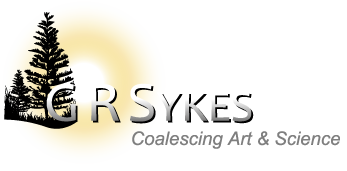About G.R. Sykes
Throughout his life, Greg Sykes builds bridges between disciplines. He started drawing and painting at an early age, with many of his subjects inspired by nature. Photography entered his skill sets as he took snapshots of subjects he intended to paint later, but the filmed images could soon stand on their own. At the same time, he wanted to learn more about nature, leading him to study the sciences, especially biology. As a teenager, he started a reef tank (building the filtration system from scratch) to propagate corals and, considering our increasingly polluted seas, provide a sanctuary for a few marine invertebrate species.
Greg’s early jobs and education helped lay down a foundation for a multi-disciplined career. Those jobs—both paid and volunteer—included animal care at a pet store, aquarium upkeep (artificial stream habitat simulation, Aplysia maintenance, and fish held for population studies), and commissioned art projects. While earning a Bachelor’s of Science degree in Biology (Chemistry minor) from George Mason University (GMU), he received training in field biology and archaeology techniques. A Smithsonian Institution internship award for genetics research eventually grew into his thesis. Graduate school refined the biological studies to both molecular genetics and environmental policy. It also gave him experience on how to run every aspect of a molecular biology laboratory—from cleaning glassware to budget management to critically important laboratory safety. The result was a published thesis, where he analyzed DNA from grass populations to demonstrate the relationships within a genus found in Mexico, Argentina, and Bolivia but nowhere in between. During this period, Greg’s artwork was inspired by his both studies and the natural world. Surrealism provided a healthy respite from data analysis.
Following graduation, Greg’s part-time job at a small environmental and toxicology firm became a full time occupation. There, he researched toxicology studies, reviewed legal casework and depositions, prepared summaries for the company president (an expert witness), and conducted field tests and sample collections for hazardous material analysis. After transferring to a biological repository, he used several different DNA testing techniques to identify laboratory specimens. His work helps assure that other scientists using the cultured material are actually investigating the correct sample and not a switched or cross-contaminated specimen. The culmination of Greg’s scientific work led to his inclusion into the American Type Culture Collection (ATCC) Standards Development Organization. This international group of scientists created universally accepted criteria for which all cultured human cell lines must be authenticated prior to either publication or receiving federal funding. Greg shares his knowledge of science through education, including publishing in peer-reviewed journals, teaching appointments, and lectures at GMU.
Again balancing art and science, Greg is currently a molecular biologist at ATCC and served as the staff photographer from autumn 1997 until June 2010. As a photographer, he interacted with every department, fulfilling imaging needs such as photographing experimental set-ups and laboratory procedures, cell cultures (animal, bacterial, and fungal subjects), conferences, social events, senior management portraits, and the facility’s architecture. He was instrumental in establishing a laboratory program in which technicians use digital microscopy to photograph cultured cells at different densities and create web pages displaying these images. The micrograph web pages help both fellow employees and external customers study the particular culture’s morphology and confluence. Whereas his work started with black & white darkroom processing and color film photography (both 35 mm and large format), he transitioned ATCC to digital image capture.
Outside of the corporate world, Greg continues freelance photography for institutions and individuals to this day. Keeping active in field ecology, he is an environmentalist involved with causes such as habitat restoration, sustainability, natural resource protection, and Chesapeake Bay watershed clean-up efforts. Greg believes that being a true biologist and nature lover is more than simply hiking or making nature a photography or art subject while pollution and invasive species harm the environment. Helping the environment and teaching others to do so is his way of repaying nature while gaining an intimate understanding of life. He frequently engages in watershed cleanups and works closely with the Fairfax County Park Authority, most notably in the Invasive Management Area (IMA) program. His efforts as an IMA volunteer site leader received recognition through the Volunteer Excellence Award (2008, presented by the Resource Management Division), the prestigious Elly Doyle Special Recognition Award (2010, bipartisan nomination by Fairfax County Board of Supervisors Chairman Sharon Bulova-D and Braddock District Supervisor John Cook-R), the Braddock District Community Champion for 2012, and Best of Braddock for 2014.
Click for the complete list of publications and presentations by Greg Sykes or for his Eco-Article series.
